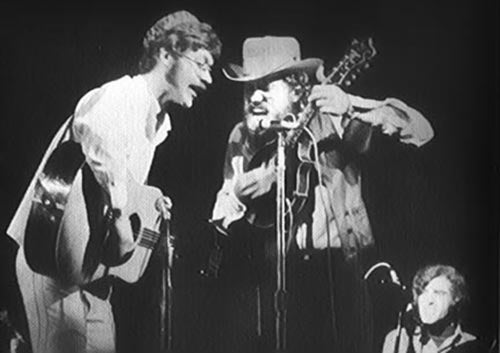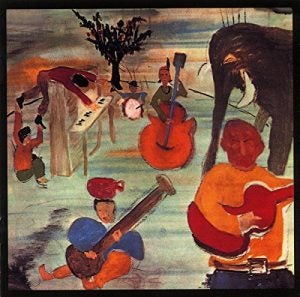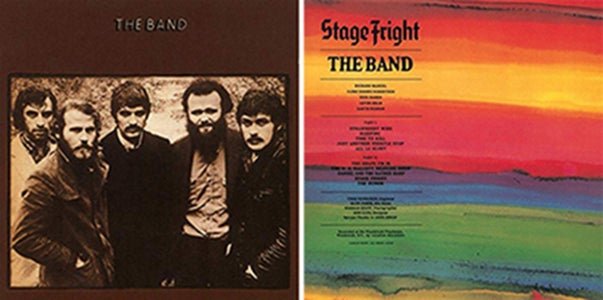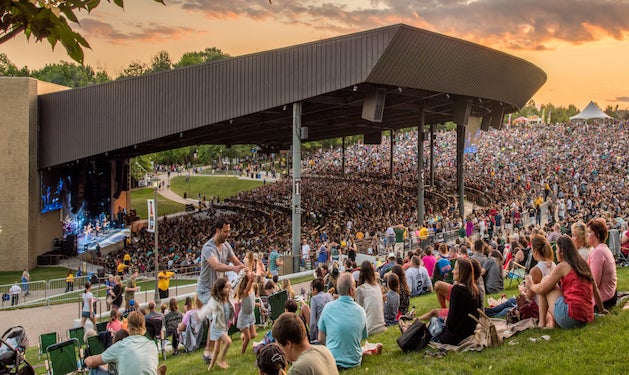From the moment the Woodstock festival was announced, people hoped that Woodstock, New York’s most famous citizen, Bob Dylan, would make an appearance. Seeing The Band on the posters and advertisements for the festival only poured fuel on the fire. Dylan didn’t come to the festival, but his former backing band did, and they performed most of their debut album for an enthusiastic audience.
Day Three, Performer 4: The Band
Performed Sunday night, August 17, 10:00–10:50 pm

Robbie Robertson, Levon Helm, and Robert Manuel of The Band performing at Woodstock. Not pictured are Garth Hudson and Rick Danko.
The Band Members
- Robbie Robertson: guitar, vocals
- Garth Hudson: organ, keyboards, saxophone
- Richard Manuel: piano, drums, vocals
- Rick Danko: bass, vocals
- Levon Helm: drums, mandolin, vocals
The Band Woodstock Setlist:
- Chest Fever
- Baby Don't You Do It
- Tears of Rage
- We Can Talk
- Long Black Veil
- Don't Ya Tell Henry
- Ain't No More Cane
- This Wheel's on Fire
- I Shall Be Released
- The Weight
- Loving You is Sweeter Than Ever
Canadians Robbie Robertson (guitar), Garth Hudson (organ), Richard Manuel (piano), and Rick Danko (bass) and American drummer Levon Helm had learned their craft as members of Canadian rockabilly superstar Ronnie Hawkins’ backing band, The Hawks. After much touring around Canada, they broke away from Hawkins in 1964 following a dispute over repertoire and toured independently as both Levon and The Hawks (the distinctively-voiced Helm being considered the frontman at this time) and as The Canadian Squires. After being recommended to him by blues virtuoso John Hammond Jr., Bob Dylan hired Levon and The Hawks to back him on his legendary 1965 and 1966 tours, during which time Dylan & The Hawks would receive all manner of boos and assorted expressions of anger from folk purists who saw Dylan’s association with the loud R&B group as sacrilegious to Dylan’s original folk sound. Tiring of the abuse from their audiences, Leon Helm quit the group in late 1965, and the band soldiered on through the spring of 1966 with a succession of drummers (eventually settling on future actor Mickey Jones), changing the very face of rock music in the process.
Following their spring 1966 European tour, The Hawks returned to New York City to await their next tour with Dylan, though these plans were scrapped after Dylan broke his neck in a motorcycle accident near his home outside of Woodstock, New York. As The Hawks were still on retainer with Dylan, they moved to Saugerties, near Woodstock, with Danko, Hudson and a recently-rejoined Levon Helm living in a Pepto Bismol-colored house in the woods that the group referred to as Big Pink. At Big Pink, they recorded informally together over the course of 1967, producing a legendary batch of material later released as The Basement Tapes. In their back-to-the-roots approach to this music, they were going against the psychedelic grain of the Summer Of Love, once again changing the face of rock music as the material began to be circulated underground and through music publishing demos.
While in Saugerties, The Hawks had always been referred to as “the band” by Dylan’s associates, so it was only natural that The Band would emerge as the official new name for the band when they began to seek a recording contract early in 1968. Signing to Capitol Records, they released their debut album, Music from Big Pink (complete with cover art by Bob Dylan) in July 1968, and their roots-inspired music was critically acclaimed and well-received by their musical peers, even if commercial success was slow in taking off. The group-penned anthem “The Weight” caught on with FM disk jockeys, however, and The Band slowly began to pick up a following. The Band’s first live performance was at Stony Brook University on New York’s Long Island in the spring of 1969, kicking off a sporadic series of shows that led them to the Woodstock Music & Art Fair in August.

featuring cover art by Bob Dylan,
was released in July of 1968.
With the crowd that made up Woodstock Nation continuing to thin out, The Band was, arguably, the group that embodied the spirit of the era more than any other. As was typical of their live performances, Robbie, Garth, Rick, Richard, and Levon were set up on stage as though they were back in their basement or in someone’s living room, facing more towards each other than lined up for the audience. They seemed to be playing to and for one another, and the music they produced was some of the best of the festival, even though band members didn’t think it was their best performance.
They opened with a tight and bluesy “Chest Fever,” drummer Levon Helm and bassist Rick Danko sharing vocal duties. After a grooving nod to their R&B roots with a cover of Marvin Gaye’s classic “Baby Don’t You Do It,” the band eased into a highly emotional version of “Tears Of Rage.” This ballad was co-written by Dylan and Band pianist Richard Manuel, and sung by Manuel in a beautiful, pleading voice. “We Can Talk” was next, the lines “one voice for all/echoing along the hall” being a brilliant distillation of the ragged-but-right harmonic vocal approach of The Band. Rick Danko was given his first lead vocal with an outstanding cover of Lefty Frizzell’s “Long Black Veil,” the only song not composed by either The Band or Bob Dylan that was included on Music From Big Pink. Levon Helm then came out from behind the drum kit (Richard Manuel taking his place), and with mandolin in hand he performed the goofy and fun “Don’t Ya Tell Henry,” a Bob Dylan song they had recorded with him during the demo sessions in the basement at Big Pink. This was followed by a soulful rendition of the traditional “Ain’t No More Cane,” a traditional song that emerged from the harsh environment of early twentieth-century southern prisons.
All this was well and good for the Woodstock crowd, but after coming off the crazed Ten Years After assault, the crowd wanted something BIG. The rumor was that Bob Dylan himself would join The Band for this performance, and shouts of “where’s Dylan?” were lobbed at the stage, requests that would go unanswered. Instead, The Band wound down their set with a pair of Dylan tunes which were at this point officially unreleased (by Dylan himself, though both had been included on Music From Big Pink) but whose Big Pink basement recordings were now in general underground circulation. These were “This Wheel’s On Fire,” a collaboration between Dylan and the song’s lead vocalist Richard Manuel, and a stunning rendition of “I Shall Be Released” (marking the song’s third Woodstock appearance) complete with another heart-wrenching Richard Manuel lead vocal.
The final number of the main set was the one Band tune most of the crowd would be familiar with, Band guitarist Robbie Robertson’s classic “The Weight.” This broke through to the crowd (it had recently been featured in the classic countercultural movie Easy Rider), and The Band earned themselves an encore. For this they pulled out another cover, a version of The Four Tops’ R&B hit “Loving You Is Sweeter Than Ever,” sung with wide-eyed wonder by Rick Danko. Tragically, The Band felt that their Woodstock performance was not up to snuff and refused to have any part of it used in either Michael Wadleigh’s documentary or its soundtrack album.
After Woodstock, The Band recorded six more studio albums, each a classic in its own right and, after relocating to Los Angeles they continued to tour off and on while most of the group grappled with fame and substance abuse issues. The Band performed their last concert in their original configuration, dubbed “The Last Waltz,” in November 1976, and it was a major event, with special guests including Bob Dylan, Paul Butterfield, Neil Young, Emmylou Harris, Ringo Starr, Ronnie Hawkins, Dr. John, Joni Mitchell, Van Morrison, Muddy Waters, Ronnie Wood, Eric Clapton, and others. A film and album of the concert were released in 1978. The Band reunited in various forms starting in 1983 but never again performed with all five original members.

two of their best albums, one simply titled The Band (1969)
and Stage Fright (1970).
Four more studio albums were to follow.
In addition to his work in the reunited Band, Richard Manuel occasionally performed with Rick Danko and others, but he suffered from severe depression and drug dependency and took his own life while on tour with The Band in 1986. Rick Danko collaborated with members of The Byrds and The Flying Burrito Brothers, Paul Butterfield, and Ringo Starr before dying of heart failure exacerbated by years of drug abuse in 1999. Levon Helm pursued a successful career as an actor and as a solo artist, creating his famous Midnight Rambles in his studio/barn in Woodstock, New York that continue to this day. Levon died of throat cancer 2012. Robbie Robertson continues to pursue a successful solo career and has scored the music for numerous films by his friend Martin Scorsese. Garth Hudson still lives near Woodstock and has been a prolific session musician, working with well over 100 other musicians.
—Wade Lawrence & Scott Parker
